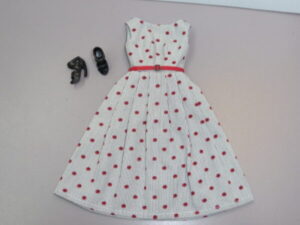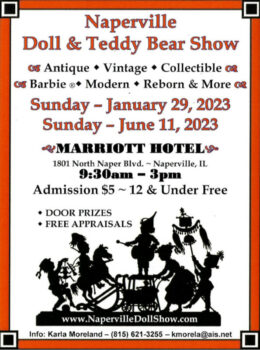 Barbie has obviously always been a fashion icon. But she’s also been a mirror of the times. Her wardrobe has changed rapidly over the years to reflect the shifting social norms, evolution of women’s roles, and the styles that defined decades. That’s why vintage Barbie clothing offers more than just aesthetic value: it’s a record of how America dressed, dreamed, and redefined itself over time. Each outfits tells a story—not just of Barbie, but of the culture that created her. Here at Gigi’s Dolls and Sherry’s Teddy Bears, we
Barbie has obviously always been a fashion icon. But she’s also been a mirror of the times. Her wardrobe has changed rapidly over the years to reflect the shifting social norms, evolution of women’s roles, and the styles that defined decades. That’s why vintage Barbie clothing offers more than just aesthetic value: it’s a record of how America dressed, dreamed, and redefined itself over time. Each outfits tells a story—not just of Barbie, but of the culture that created her. Here at Gigi’s Dolls and Sherry’s Teddy Bears, we
Barbie’s Closet as a Cultural Timeline
From Housewife to Career Woman
In her earliest years, Barbie reflected the idealized woman of the 1950s and early 1960s—stylish, poised, and often dressed for cocktail hour or Sunday brunch. Outfits like “Wedding Day Set” and “Gay Parisienne” mirrored the fashion of upper-middle-class America, when femininity was defined by elegance and structure.
But by the late 1960s, Barbie’s wardrobe began to shift. She took on careers, sported pantsuits, and donned styles that reflected a more independent woman. Her closet evolved with her identity—no longer just a symbol of fashion, but of aspiration. Her career-themed outfits weren’t just accessories; they were statements about possibility.
Miniature Fashion Inspired by the Real World
Many of Barbie’s most memorable outfits drew direct inspiration from real-life figures and contemporary fashion trends. Pillbox hats and structured coats recalled Jacqueline Kennedy’s First Lady wardrobe. Disco jumpsuits captured the Studio 54 glamour of the late ‘70s. Power suits with shoulder pads were unmistakably tied to the executive styles of the 1980s.
In miniature form, Barbie captured the essence of American pop culture. Here clothes tracked not only what women were wearing, but what they were reaching for—more freedom, more opportunity, and more expression. And because of collectors who have properly cared for their dolls and outfits, many of them are still around today.
How Barbie Reflected—and Shaped—Social Change
Civil Rights Era and Inclusive Design
Though Barbie’s journey toward true inclusivity took time, changes in her wardrobe reflected growing awareness. The introduction of dolls with diverse skin tones and culturally inspirited clothing showed that fashion could reflect broader movements toward equity and recognition. Even subtle wardrobe changes—like afros in the 1970s or outfits that reflected non-Western influence—demonstrated Mattel’s evolving understanding of Barbie as a symbol of identity and acceptance.
Fashion as Aspiration and Empowerment
By the 1980s, Barbie’s wardrobe started filling up with clothing that embodied ambition. She wasn’t just going to the ball—she was leading meetings, working in medicine, flying planes, and serving in the military. Her clothing began to reflect these new roles. Lab coats, uniforms, and smart business wear became part of the fashion lineup, reinforcing the idea that style and substance could exist side by side. It was a message that resonated with girls and collectors alike: Barbie could look fabulous and be powerful at the same time.
A Fashion History Lesson in Each Outfit
Fabrics, Colors, and Patterns of the Time
Just like real fashion, Barbie’s clothing was influenced by what was happening in textiles and design. In the 1960s, bold floral prints, metallic brocades, mod color blocking were everywhere. The ‘70s embraced earth tones, suede-like materials, and bohemian patterns. The ‘80s exploded with neon, metallic, and high-shine synthetic fabrics. Even the details—zippers, buttons, hemlines—reflect real trends in garment construction. Collectors often study these subtle cues to date and authenticate outfits, but they also serve as snapshot of what was considered stylish in a given decade.
Understanding Historical Value Beyond Rarity
While rarity can increase an item’s value, historical significance often holds equal weight for collectors. An outfit may not be hard to find, especially in the era of reproductions, but its place in cultural memory—what it represented at the time—can make it deeply desirable. For example, Barbie’s “Business Executive” ensemble isn’t the rarest outfit in circulation, but it speaks volumes about the role of women in the workforce in the 1960s. In this way, collecting vintage Barbie fashion has become a way of preserving social commentary in addition to clothing.
Connecting Cultural Significance with Collecting Strategy
Collecting by Theme or Movement
Some collectors organize their wardrobes by cultural themes rather than by era. Outfits tied to women’s empowerment, diversity, or political change become meaningful groupings. Others create mini-histories through Barbie’s fashion —documenting her transition from homemaker to trailblazer in carefully chosen outfits. There’s no right way to do it but considering what each outfit says about the time it came from can add a deeper enjoyment to the hobby.
Why Cultural Context Deepens Value
When you understand the context in which an outfit was designed, it enriches the collecting experience. It’s not about the look, it’s about the message. Barbie’s clothes are miniature reflections of a larger cultural fabric. They show how style and social awareness have always been intertwined, even in the world of toys.
As you grow your collection, the outfits you choose can say as much about the culture you’re honoring as they do about Barbie herself. If you want a wardrobe that tells the story of both fashion and change, we can help. Gigi’s Dolls and Sherry’s Teddy Bears sells vintage Barbie dolls, clothes, and accessories from across various eras of recent American history. Contact us today to learn more!


